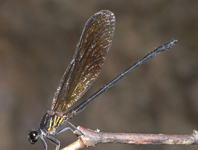Abstract
Caltoris ranrunna (Sonan, 1936) is resurrected from synonymy of Caltoris cahira austeni (Moore, 1883) to represent a Caltoris species endemic to Taiwan based upon COI barcode divergence and morphological diagnosis in genitalia of both sexes. This species distributes allopatrically from C. cahira of continental Asia and Andamans.
References
Braby, M.F., Eastwood, R. & Murray, N. (2012) The subspecies concept in butterflies: has its application in taxonomy and conservation biology outlived its usefulness? Biological Journal of the Linnean Society, 106, 699–716.
https://doi.org/10.1111/j.1095-8312.2012.01909.x
Chiba, H., Hsu, Y.F. & Shirôzu, T. (1992) Hesperiidae. In: Heppner, J.N. & Inoue, H. (Eds.), Lepidoptera of Taiwan. Vol. 1. Part 2. Checklist. Association for Tropical Lepidoptera, Gainesville, pp. 130–132.
Chou, I. (1994) Monographia Rhopalocerorum Sinensium. Henan Scientific and Technological Publishing House, Zhenzhou, 854 pp.
Edgar, R.C. (2004) MUSCLE: multiple sequence alignment with high accuracy and high throughput. Nucleic Acids Research, 32, 1792–1797.
https://doi.org/10.1093/nar/gkh340
Eliot, J.N. (1992) The butterflies of the Malay Peninsula. 4th Revised Edition. The Malayan Nature Society, Kuala Lumpur, x +595 pp., 69 pls. [originally by Corbet A.S. & Pendlebury, H.M.]
Evans, W.H. (1949) A Catalogue of the Hesperiidae from Europe, Asia and Australia in the British Museum (Natural History). British Museum, London, 502 pp.
https://doi.org/10.5962/bhl.title.105941
Hamano, E. (1987) Ecological Encyclopedia of Taiwanese Butterflies. Kodansha, Tokyo, 474 pp. [in Japanese]
Hebert, P.D.N., Cywinska, A., Ball, S.L. & deWaard, J.R. (2003) Biological identifications through DNA barcodes. Proceedings of Royal Society, B, 270, 313–322.
https://doi.org/10.1098/rspb.2002.2218
Hebert, P.D.N, Penton, E.H., Burns, J.M., Janzen, D.H. & Hallwachs, W. (2004) Ten species in one: DNA barcoding reveals cryptic species in the neotropical skipper butterfly Astraptes fulgerator. Proceedings of the National Academy of Sciences of the United States of America, 101, 14812–14817.
https://doi.org/10.1073/pnas.0406166101
Hsu, Y.F. & Wang, S. M. (2004) Notes on immature biology of a rare skipper Caltoris bromus yanuca Fruhstorfer (Lepidoptera: Hesperiidae), with a discussion on the systematic status of Parnara ranrunna Sonan. Pan-Pacific Entomologist, 80, 70–81.
Huang, H. (2011) Notes on the genera Caltoris Swinhoe, 1893 and Baoris Moore, [1881] from China (Lepidoptera, Hesperiidae). Atalanta, 42 (1–4), 201–220.
Miller, M.A., Pfeiffer, W. & Schwartz, T. (2010) Creating the CIPRES Science Gateway for inference of large phylogenetic trees. Gateway Computing Environments Workshop (GCE), 2010, 1–8. [Ieee]
https://doi.org/10.1109/GCE.2010.5676129
Ronquist, F., Teslenko, M., Van Der Mark, P., Ayres, D.L., Darling, A., Höhna, S. & Huelsenbeck, J.P. (2012) MrBayes 3.2: efficient Bayesian phylogenetic inference and model choice across a large model space. Systematic Biology, 61, 539–542.
https://doi.org/10.1093/sysbio/sys029
Rozas, J., Ferrer-Mata, A., Sánchez-DelBarrio, J.C., Guirao-Rico, S., Librado, P., Ramos-Onsins, S.E. & Sánchez-Gracia, A. (2017) DnaSP 6: DNA Sequence Polymorphism Analysis of Large Datasets. Molecular Biology and Evolution, 34, 3299–3302.
https://doi.org/10.1093/molbev/msx248
Stamatakis, A. (2014) RAxML version 8: a tool for phylogenetic analysis and post-analysis of large phylogenies. Bioinformatics, 30 (9), 1312–1313.
https://doi.org/10.1093/bioinformatics/btu033
Shirôzu, T. (1960) Butterflies of Formosa in Colour. Hoikusha, Osaka, 481 pp. [in Japanese]
Sonan, J. (1936) Notes on some butterflies from Formosa. Zephyrus, 6, 205–216, 3 pls. [in Japanese]
Tamura, K., Stecher, G., Peterson, D., Filipski, A. & Kumar, S. (2013) MEGA6: Molecular Evolutionary Genetics Analysis Version 6.0. Molecular Biology and Evolution, 30, 2725–2729.
https://doi.org/10.1093/molbev/mst197
Zhang, Y.L., Xue, G.X. & Yuan, F. (2010) Descriptions of the female genitalia of three species of Caltoris (Lepidoptera: Hesperiidae: Baorini) with a Key to the species from China. Proceedings of the Entomological Society of Washington, 112, 576–584.
https://doi.org/10.4289/0013-8797.112.4.576

